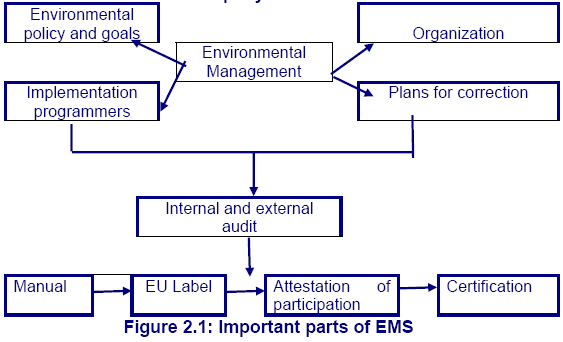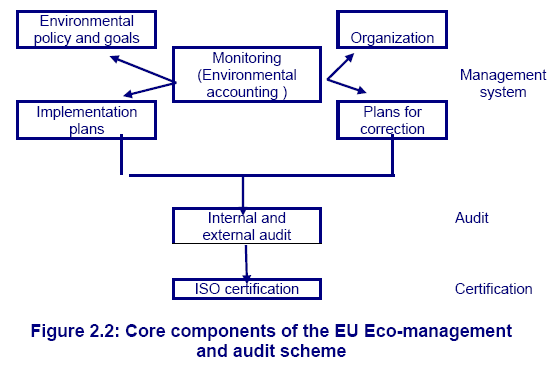|
2.1 EMS: Definition and Concepts
For the last ten years various stakeholders
defining standards of good environmental management practice
have influenced corporate strategies for environmental
management and environmental information. The growing importance
of environmental management is reflected by number of important
regulations and standards in force or being prepared, all with
the aim of harmonizing environmental management practices and
procedures. Standardization and its application to company
systems are the most important aspects of effective
environmental management Standards can be technical, related to
performance, or can be process-based and they provide the
foundation for continual improvement in relation to
established benchmarks. Among the most significant
standards in recent time are BS 7750 (BSI 1992), the EU
directive on EMS and standard ISO and 14004 (or ISO 14004 for
companies not seeking certification of ISO (1994a, 1999a). ISO
14001, which is now being adopted widely, is a process standard
ISO currently developing a family of environmental management’
standards that address management systems and environmental
aspects of products in the areas of life-cycle assessment, (LCA)
(ISO 14040), labeling, (ISO 14020), and environmental
performance evaluation.
Standard-setting organization
such as the BSI, ISO as other national standard-Isetan
organization have formulated standards against which corporate
management systems can be audited. These standardization
organizations are private institutions financed by industry.
Their markets (i.e. sales) depend on the price of auditing and
certification services as well as on the reputation of
organization for ensuring that the material audited is of a high
quality. The quality of these auditing services is, in turn,
checked by regulators, who verify corporate environmental audit.
BS 7750, released as a draft standard in
1992
(and released as an actual standard in 1994) was the first
standard for corporate environmental management systems. It has
substantially influenced ISO 14001, which was published as a
draft version in 1994 and as final document in 1996 (Hillary
1995: 294 Sheldon 1996; Tibor and Feldman 1997). Although ISO
14001 encompasses the general element of 7750, it allows greater
flexibility in application.
A major motivation for companies to
establish environmental management systems comes from the
European Commission’s (COM) introduction of the voluntary
EMS for production sites and companies. The term “ audit “ could
be misleading, because EMS covers much more than a traditional
legal compliance audit. EMS enables companies to have their
audited according to criteria for good environmental management
practices and, if they fulfill the requirements of the
directive, to use (restrictively) a label that confirms that a
specific site has an environmental management system in place
and that it has successfully completed an external environmental
audit. The label can only be used on a letterhead or on
environmental and financial reports and is not attached to
products.
As shown in the following in Figure 2.1, an
important part of EMS focuses on the process of ensuring that an
environmental management system is in place and functioning
To comply with the provisions of EMS,
a company must have implemented an environmental management
system that helps to:
§
Formulate an environmental policy
and goals for corporate environmental protection.
§
Secure efficient environmental
accounting (or information management)
§
Evaluate environmental performance
(and support decision-making)
§
Plan and steer company activities.
Figure 2.1: Important parts of EMS

·
Implement the respective plans
·
Build up
an
effective and efficient organization
·
Communicate with internal and external
stakeholders (Environmental Reporting)
In
addition, the existence and functioning of the corporate
Environmental management system has to be verified by external
auditors.
Companies that comply with these
requirements are free to display logo on their letterhead;
something that it is hoped would become a mark of environmental
excellence. It was expected that market pressure, especially in
inter-corporate business relationships, would encourage
companies to participate EMS. However, as an economic analysis
of the incentives provided by EMS and early experience show,
this reason for participation may be overestimated in the past
In addition, competition continues between EMS and ISO 14001 as
alternative Environmental management standards. Frequent reports
on the relative take-up of these of these rival schemes continue
Emphasis on membership and cost is critical; for example, ISO
reversals More than 80% of 500 companies surveyed on their
experiences with implementation of [ISO] Environmental
management systems (EMS) found them to be cost-effective, with
over 60% quoting payback periods on their investment of less
than 12 months.
The Idea behind ISO 14001
can be shown in Figure 2.2. The main requirements for the ISO
Environmental management system are similar to those of EMS. The
company must establish:
§
An Environmental policy.
§
An Environmental accounting or
monitoring system.
§
Implementation plans.
§
Plans for correction.
§
An effective and efficient organization.
Figure 2.2: Core components of the EU Eco-management and audit
scheme

As
with EMS’s 1998 changes that extended the scheme to
non-industrial companies, external revision of the ISO corporate
Environmental management system is necessary for companies to
adopt external ecological reporting.
Also, EMS until 1998) and ISO were both site-oriented However
14001 does not exclude the application of its standard to
products. Just as with quality standard ISO 9000, strong
pressure was expected to be exerted on companies which have
their production sites certified. First tendencies show that in
some business-to-business relationships the fulfillment of an
environmental management standard is becoming a requirement for
suppliers. Differences between the standards are small- apart
from the fact that ISO 14001 does not require a public
disclosure of environmental impacts.
BS
7755, EMS and ISO 14001 define requirements for corporate
environmental management systems. However, none of these
standards specifies how the requirements should be fulfilled,
nor do they provide an indication of what goals corporate
environmental management should strive to achieves for the
importance of parallel changes to corporate culture,
All
standards emphasize the need for Environmental management
control as well as the need for Environmental, and particularly, accounting as an important part of corporate
environmental management. Nonetheless, the standards do not
provide any methods for the management or implementation of
decision-making processes (i.e. through incentive systems).
|